by Todd Walker
Work smarter, not harder.
My daddy’s words echo in my head every time I’m half bent over a project. They rang true recently when a red oak branch fell and crushed my backyard fence.
I cranked ‘Big Orange’ (my chainsaw) and sliced through the limb like a hot butter knife through butter. The thought re-emerged in my cluttered mind, thanks to the fence supporting the limb at waist height, that I needed to build something to hold all the long firewood about 3 feet off the ground while Big Orange made shorter firewood.
A sawbuck was in my future!
Sawbucks were common in pioneer days before the advent of modern chainsaws. This woodpile tool is a simple trestle with cross bracing that not only cradles logs but is responsible for saving the backs of millions of homesteaders.
Let’s get started building you a cheap, but sturdy, sawbuck shall we!
Material needed:
- Eight – 4 foot 2×4’s – I used leftover pieces I had lying around my shop. You can purchase three 8 footers from the lumber store for under 10 bucks.
- Three bolts (about 4 inches long each), 9 washers, 3 nuts. I repurposed some hardware from a wooden swing set I disassembled years ago.
- 18 – 3 1/2 inch screws for the brace pieces. Again, already had these on hand.
Tools needed:
- Saw – circular or miter
- Drill and bit sized to match the size of your bolt.
- Impact driver or drill to sink screws. You could use a screw driver if you have scary strong forearms. Or just hammer nails to fasten the braces.
- Measuring device and a pencil.
- Straight edge or framing square.
- Flat surface for assembly.
- Ratchet, socket, wrench to tighten nuts.
- Speed square if you’re not using a miter saw.
Step 1: Cut boards to 4 foot lengths. Set aside 2 of the boards for bracing. On the end of each of the other boards, cut a 30 degree angle on each. I used a powered miter saw. Be sure to leave the boards 4 foot long after the angle cut.
Step 2: Measure 18 inches down from the square end and mark all 6 of the angled boards. This marks the spot for your bolts to hold the cross pieces together.
Step 3: Drill a hole in the center of each board on the line you just marked. The diameter of the hole needs to match the bolt you’re using. Use a drill press if you have one. If not, drill as straight as you can with a hand-held drill motor.
Step 4: Assemble the cross pieces by inserting bolts and washers through three pairs of boards. I used 2 washer on the outside and one in between each pair to help with folding the sawbuck for storage. The middle washer is not necessary. Tighten the nuts. You don’t have to torque the nuts too tightly. Just enough to hold and be able to easily fold the sawbuck when not in use.
Now you have three cross pieces assembled.
Step 5: Fold each cross-piece together so the edges are flush. Lay them on a flat surface and measure 20 inches down from the square end and make a mark on the edge of each board. This where you’ll place the top edge of your bracing boards.
Lay the cross pieces edge side up on a flat surface. Space the two end cross pieces 4 feet apart. Now center the middle cross-piece between these two.
Lay your first brace on the 20 inch mark. Drive two screws (pre-drill holes) into three of the cross piece legs. You may want to pre-drill pilot holes to prevent splitting your brace wood. Use pressure treated wood if you’re buying lumber for this project. I used untreated because that’s what I had.
Important note: Flip the sawbuck over and attach the next brace to the opposite legs on the other side of the sawbuck. If you attach the braces to the same legs, it won’t fold out.
Step 6: Set up your new sawbuck. Unfold the sawbuck until the legs meet the bracing. You can adjust the height by either moving the brace up on the legs of the sawbuck or attach an adjustable chain to the outside legs of the sawbuck.
Advantages of sawbucks:
- Raises logs to a comfortable height for sawing
- No chance of grounding your chainsaw blade in the dirt
- Essential for building your log cabin in the woods
- Secures round logs. Round things tend to roll away
- Cheap to build
- Fold up for compact storage
- Safety – lessens the chances of kickbacks than sawing firewood on the ground or in a pile
- Saves your back – especially if you’re using a crosscut or other man-powered saw!
Here’s my sawbuck in action.
To raise the height of your sawbuck, screw the two brace boards at 19 inches instead of 20 inches as described in Step 5. When firewood cutting season is over, fold it and storage it.
Hope you enjoyed this simple project. Let us know if you have comments, questions, or suggestions to make our sawbuck better.
Keep doing the stuff!
Todd
P.S. – You can also keep up with the Stuff we’re Doing on Twitter, Pinterest, Google +, YouTube and our Facebook page… and over at the Doing the Stuff Network on Pinterest, Google +, and Facebook.
P.P.S – If you find value in our blog, Dirt Road Girl and I would appreciate your vote on Top Prepper Sites! You can vote daily by clicking here or on the image below. Check out all the other value-adding sites while you’re there…
Thanks for Sharing the Stuff!
Copyright: Content on this site (unless the work of a third-party) may be shared freely in digital form, in part or whole, for non-commercial use with a link back to this site crediting the author. All links in articles must remain intact as originally posted in order to be republished. If you are interested a third-party article, please contact the author directly for republishing information.

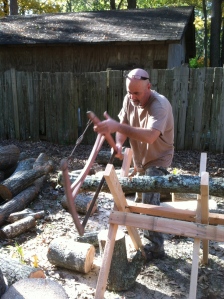

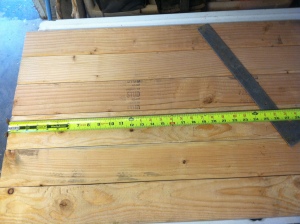
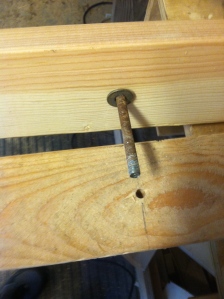
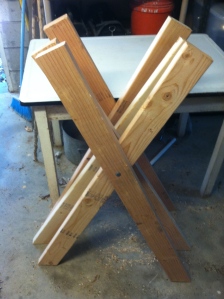
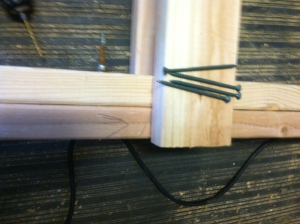
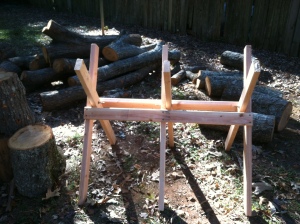
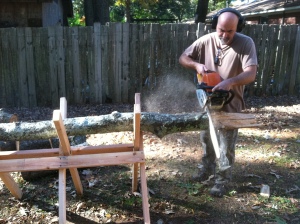
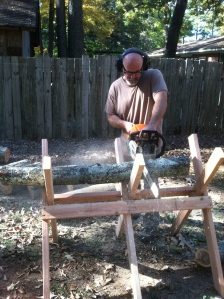








Great aid if you have a wood heater and cut a lot of firewood. Simple and straightforward and cheap.
LikeLike
I’ve been looking for something like this for a while. Thanks! I’m going to build one today.
LikeLike
How do you get the logs on the sawbuck? planning to make this for my father who’s getting old in age and want to know good ways to save his back.
LikeLike
Use iceblock/log tongs and a block&tackle to a tree branch
http://www.icollector.com/Large-Antique-Iron-Ice-Tongs-Log-Grabber_i10153407
There are lot-o-tools
http://www.motherearthnews.com/diy/build-a-log-lifting-tool-zmaz82sozgoe.aspx
LikeLiked by 1 person
Good advise, Pismo!
LikeLiked by 1 person
Being raised mostly on somewhat primitive farms in the late 30’s and forties, I’ve used many “saw horses” (maybe there’s a difference), generally with just four legs and not made to fold. One I made, and liked best, resulted from others being wobbly. I drove two sticks, perhaps 2x4s, into the ground in crosses, then two more nearby, nailed the crosses together and put diagonal leg braces between the two sets. No more problem with wobbling.
Dan
LikeLike
It goes without saying, but use carriage bolts on the outside legs so they are recessed so you will be less likely to catch your saw on the metal if the log shifts as you are cutting. And hacksaw off excess bolts protruding beyond the nuts in case you make a cut in between the legs.
LikeLike
I just got done building this. Been killing my back trying to cut on the ground. Excellent post and easy to follow instructions great job. Plus as a bonus I got my first fire started with a ferro rod and tinder bundle yesterday (definitely getting the 6in version though). Love the site.
LikeLiked by 1 person
Awesome, brother! Glad it helped.
Yep, that 6 inch ferro rod throws molten lava! 🙂
LikeLike
Great article, Todd! Simple design, clear instructions. That’s Doing the Stuff!
LikeLike
Appreciate you, Mark!
LikeLike
Pingback: Ax-Manship: Tips for Splitting Long Logs for Firewood | Survival Sherpa
This is an awesome guide. I only had one small issue. 20″ down for the braces didn’t seem right with 30° angle feet. I found 19″ to be the magic number.
LikeLike
Thank you, Anthony! Glad you found the right angle for your sawbuck.
LikeLike
Pingback: Ax-Manship: Tips for Splitting Long Logs for Firewood | Ready Nutrition
Pingback: Ax-Manship: Tips for Splitting Long Logs for Firewood » Survival Gear & Food Storage
Pingback: Ax-Manship: Tips for Splitting Long Logs for Firewood | TheSurvivalPlaceBlog
Thanks for the measurements. Saved my fickle brain the second guessing.
I added a 2×6 brace board on both sides, 2 inches from the ground to reduce the racking that it wanted to do.
Love that it folds away.
LikeLike
The folding part is a good feature. Thanks for sharing your mod, Bruce!
LikeLike
Make that a 1×6.
LikeLike
Pingback: How to Build a Sturdy Sawbuck with Logs and Rope | Survival Sherpa
Pingback: Made by Hands: Make it or Buy it? | Survival Sherpa
Pingback: A complete guide to know what are the best chainsaws for beginners – Let's Wood | Woodworking tips and reviews
Built this today in about 1.5 hours. Nice easy instructions, went together quickly. This will definitely sace my back. Thanks Todd!
LikeLike
Excellent, James! Mine is still one of my most highly used contraptions both in my backyard and at base camp.
LikeLike
I built mine using 2 – 4×4 pallets. Remove half the top boards and put a carriage bolt through each 2×4 about the middle of each skid. Seems pretty sturdy but it does not fold.
LikeLike
Good idea, Mike, using free pallet wood. Mine folds but I hardly ever fold it up. Thanks for the update, sir.
LikeLike
Just finished making my sawbuck from you instructions. Re-purposed old 2×4 from the farm. The only new stuff was the screws for the side braces. Old bolts,nuts and washers from old machinery. Looks great.
LikeLike
Cool beans, Dave! Always great to repurpose stuff and keep you money in your wallet. Thanks for sharing your success with us!
LikeLike
I built my sawbuck using your plans with modifications, notably making mine 8ft. long to handle limbs and small legs. During assembly I found that marking the x pieces at 20″ for the braces as your suggested splayed them out too far and lowered them too much, the 30° angle on the feet didn’t set on the floor properly. I moved the mark up to 19″, moving it up to a more comfortable height and the feet sat properly on the floor. I also applied some Thompson’s water seal for protection, even though I keep it stored inside. Anyway, thanks for the great plans, thought you might like to know about the discrepancy I found.
LikeLike
Always good to hear of modifications to projects. It is a customizable sawbuck as you just proved, Tom. Thanks for sharing with us.
LikeLike